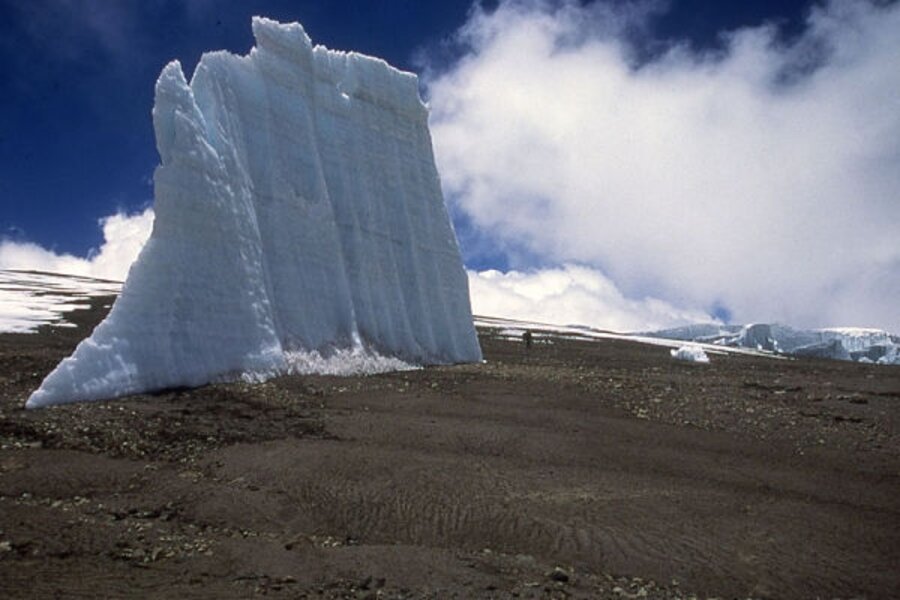Is global warming melting the ice on Mt. Kilimanjaro?
Loading...
Global warming appears to be melting the ice on Tanzania's Mt. Kilimanjaro. The summit's glaciers are likely to be gone within a few decades
That's the word from a study appearing this week in the Proceedings of the National Academy of Sciences.
But global warming may not be the whole story behind Mt. Kilimanjaro and its environs. And therein lies a tale of how human activities may affect local and regional climate in ways that can mask or reinforce a long-term warming trend.
Understanding those effects is critical to devising strategies for adapting to global warming at regional or local levels.
The new results showing how quickly ice is melting on Mt. Kilimanjaro's iconic summit comes from the lab of Lonnie Thompson, an Ohio State University glaciologist who has spent his career studying the climate records trapped in mountain glaciers in the tropics. (For a good read on his work, snag a copy of the book "Thin Ice" by Mark Bowen.)
Among the findings:
-- The summit lost 80 percent of its ice between 1912 and 2007. Some 26 percent of the ice present in 2000, Dr. Thompson's last trip to the summit, vanished by the end of the period. The Furtwangler Ice Field in particular has lost 50 percent of its thickness since 2000. At that pace, it will vanish into a damp patch of summit soil by 2018. Glaciers on Mt. Kilimajaro's flanks have lost some 40 percent of their area between 2000 and 2007.
-- One ice core Thompson's team pulled hosts oblong air bubbles at the top. Those bubbles signal repeated melting and refreezing, something that fails to appear at any other point along the core, which spans 11,700 years.
-- Even during a 300-year-long drought the region experienced 4,200 years ago, the cores show no evidence of melting and refreezing during that drought.
The ice loss is bad news for Tanzania, Thompson explains in an e-mail exchange. Tanzania's main source of foreign currency is tourism. When the glacier's vanish, will the mountain still draw 30,000 to 40,000 tourists a year, as it does now? (About 10,000 a year try to climb it.) And farmers at the mountain's base rely on glacial melt water for irrigation.
Mountain glaciers in tropical South America and the Himalayas are undergoing similar changes, Thompson's work shows.
"It is the balance of evidence and global nature of glacier-ice loss throughout the tropics that points to global climate change as the driver," he writes.
But what about the actions of folks at the base of the mountain? Might deforestation -- clearing trees for farmland -- have led to changes in temperatures and precipitation patterns that have at least contributed to, if not driven, changes at the summit?
After all, researchers have found that since 1971, temperatures at the base of Mt. Kilimanjaro have been rising faster than global warming alone would account for.
"We have no way of knowing how much of that, if any, is transmitted to the summit ice fields" some 15,000 feet above the base, Thompson acknowledges. You can download a full copy of the study, as a pdf, here.
So if the impact on the summit remains unclear, that same can't be said for the base. If Kilimanjaro becomes iconic, perhaps it deserves that status as much for the impact of human land-use changes on local and regional climate, as for the broader trend of long-term global warming.
Indeed, an increasing number of studies are suggesting that the intensity of long-term effects from global warming locally can be affected by land-use practices in the area.
Among these studies:
-- Early last month, a team led by Richard Seager at the Lamont-Doherty Earth Observatory in Palisades, N.Y., showed how drought in the US Southeast from 2005 through 2007 was run-of-the-mill by historical climate measures. Yet its effects were severe, prompting widespread water restrictions and courtroom water wars between states dipping their conduits into the same river system. The reason for so much hardship? Development and population growth in the region, which caused demand for water to explode. Even though climate models project an increase in precipitation in the region, that isn't going to bail the region out of its water problems, the team writes. Models project a slight increase in evaporation over precipitation during the course of this century. You can download a pdf of the study here.
-- The strains of crops grown, as well as approaches used to grow them that put little premium on soil conservation, likely turned a moderate drought centered in the US Southwest into a disaster embracing the Great Plains, according to a recent study by a team led by Benjamin Cook, with the Lamont-Doherty Earth Observatory in Palisades, N.Y. You can download a pdf copy here.
-- Data and modeling studies of the effects of farm irrigation in Nebraska and California's Great Central Valley suggest that widespread irrigation reduced the hottest summer temperatures in the irrigated regions by an average of nearly 7 degrees C (nearly 13 degrees F.); irrigation shaved an average of 2.7 degrees C off the heat index as well. A team led by Stanford University's David Lobell published the results in the journal Geophysical Research Letters last year. You can find a summary here.
Expect to see more of these kinds of studies as adaptation to global warming looms larger on the horizon.
Editor’s note: For more articles about the environment, see the Monitor’s main environment page, which offers information on many environment topics. Also, check out our Bright Green blog archive and our RSS feed.





